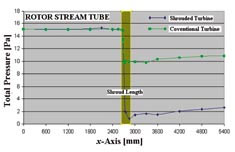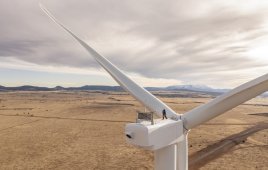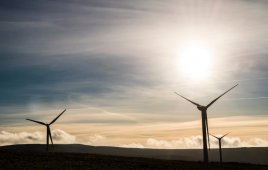Our objective while developing wind technology is to reduce costs and increase the power output of wind turbines. The principle behind our studies is to use the effect of static wing or sail structures, which convert energy more efficiently, to increase the efficiency of turbines. Many attempts have already been made during the last decades to use external shrouded systems, but with success only in wind tunnel studies, not in ambient air. The reasons become clear from our use of STAR-CD.
Based on a patent of the Grumman Corporation, a private company built a prototype at considerable expense, which failed to meet the expected success. CD Adapco’s STAR-CD studies of wind turbines with and without shrouds immediately showed the relationship between the force exerted by the flow on the turbine and transfer of both energy and linear momentum. Given a certain force, the energy transfer does not depend on the velocity of the flow, but the momentum transfer does. As a consequence, it is not possible to increase the power of a conventionally shrouded wind turbine beyond the theoretical limit for the same turbine without shroud (the so called Betz limit). With this realization, millions of dollars could have been saved before the prototype stage, with obvious benefits to the project profitability and overall success.


But the success did not stop there. STAR-CD was able to assist in finding a solution. Past shrouded systems closely fitted the propeller to minimize tip-vortex drag. If instead, one leaves a larger space between the propeller tips and the shroud, it has a beneficial effect over a wider radius of the propeller.

Fig 2: Axial wind velocity component. The direction of the vector indicates the direction of the ambient wind
Figure 1 shows one of CD Adapco’s wind turbine models, surrounded by a shroud, which is curved like a sail. The surface area of the shroud is about 3 times larger than the area covered by the rotating propeller. Figure 2 shows the velocity in a cross section through the model in the flow direction. Contrary to the conventional system, the air accelerates as it approaches the turbine, and the static shroud plays an active part in the energy extraction of the system, hence the name “partially
static turbine”.
Figure 3 compares the mean total pressure in the flow tube, which passes through the propeller for the bare wind turbine and the shrouded one. The large pressure drop for the shrouded wind turbine could in principle also be achieved in an unshrouded system, but only for small wind velocities. In the shrouded system this large pressure drop occurs while the air is moving through the propeller at a mean axial velocity of 7.2 m/sec (while the ambient wind only has a velocity of 5 m/sec) –

Figure 3: Mean total pressure in the rotor flow tube for bare and for shrouded wind turbine. The rotor flow tube is the flow tube flowing through the area covered by the rotor. The total pressure is shown as a function of x, which is the axis parallel to the ambient wind, the position and the size of the shroud are indicated by the yellow shaded area
in an unshrouded system, or in a shrouded system, which does not interact with an additional flow of air, this situation would constitute a severe violation of energy and momentum conservation.
Figure 4 compares the power of the shrouded wind turbine compared to the unshrouded design. The increase in peak power is a factor of 4.
The same principle can also be applied to water. For a given flow rate, one can significantly reduce size of a Kaplan wind turbine. Or for a given turbine size, one can produce the same power at a lower flow rate. We expect this not only to reduce the price of hydro-power, but it should also open new applications, since the partially static turbine allows for hydro power construction in places where large dams are not feasible.
STAR-CD has taught us a lot about partially static systems. Still more can be learnt in the optimization of shrouded designs and prototype builds.
We are actively searching for partners and collaborators in industry and other research institutes to take these studies to the next stage.
REFERENCES:
Bet F. and Grassmann H., ‘Upgrading conventional wind turbines’, Renewable Energy, January 2003, Elsevier Press, www.elsevier.com/locate/renene
Grassmann H., Bet F., Cabras G. Ceschia M>, Cobai D> and DelPapa C. ‘A partially static turbine – first experimental results’, Renewable Energy, to be published, ElsevierPress, www.elsevier.com/locate/renene
Ganis M., “CFD analysis of the characteristics of a shrouded turbine” www.diplom.de
Filed Under: Featured, Turbines







Our commercialize wind turbine named the WindCube augments the wind between 1.75 and 2.25 range is the improvments we realized from our prototype to our commercialized windcube. We have increased the blade diameter from 15 ft to 20 ft. This system is rated as a 50kW system. We have patented our designed and the automation of this 25ftx25ftx14ft wind turbine focused for rooftop mounting and standalone pole mounts for netmetering application. Financially for the end user the payback is three and a half years in several states and even faster in foriegn countries were the electric rates are much higher. Please see website at getsmartenergy.com
I have done my first wind tunel test on a shroud 1m diam, multiblade wind turbine in 1983. I was looking for the best low wind speed wind turbine.
I was interred in that matter but along my experience, my conclusion are as follow
– It make more sense for hydro than wind power
– For wind energy it could make sense if the wind speed is mainly one direction or 2 direction and building could be used as wind increase shroud.
– Other application, shroud weight and volume cause problem in high wind for yawing and structural tower design, which mean than something other than Class IV site is not recomended
– This solution is not very use because of economic matter, increasing rotor blade is cheaper and easier to sustain high wind speed than shroud wind turbine.